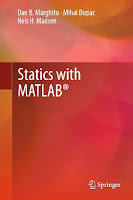Analysis of Structures: An Introduction Incl. Numerical...
 Joe G. Eisley, Antony M. Waas ... 638 pages - Publisher: Wiley; 1st edition (September, 2011) ... Language: English - ISBN-10: 0470977620 - ISBN-13: 978-0470977620 ...
Joe G. Eisley, Antony M. Waas ... 638 pages - Publisher: Wiley; 1st edition (September, 2011) ... Language: English - ISBN-10: 0470977620 - ISBN-13: 978-0470977620 ...Analysis of Structures offers an original way of introducing engineering students to the subject of stress and deformation analysis of solid objects, and helps them become more familiar with how numerical methods such as the finite element method are used in industry. Eisley and Waas secure for the reader a thorough understanding of the basic numerical skills and insight into interpreting the results these methods can generate. Throughout the text, they include analytical development alongside the computational equivalent, providing the student with the understanding that is necessary to interpret and use the solutions that are obtained using software based on the finite element method. They then extend these methods to the analysis of solid and structural components that are used in modern aerospace, mechanical and civil engineering applications.


















